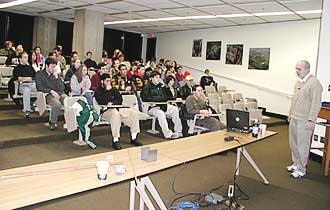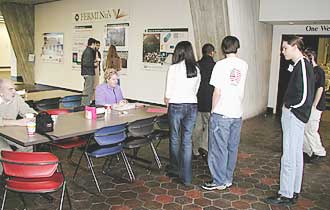The Evolution of the Saturday Morning Physics
Roger L. Dixon
Increasing the enthusiasm for science among young people was surely the motivation behind the idea for Saturday Morning Physics at Fermilab back in the early 80’s when Leon Lederman brought the idea to Fermilab. A group of volunteers from the Laboratory staff led by Drasko Jovanovic executed the idea. High school students interested in physics and nominated by their teachers and principals were invited to Laboratory on Saturday mornings for a series of 10 two-hour lectures, which introduced them to the basic ideas and instruments of particle physics. The program was an immediate success.
Between fifty and two hundred students attended the lectures, which were given in 3 sessions per academic year. Lecturers were chosen on the basis of their expertise and ability to communicate with young people. Enthusiasm for the task was also an important requirement for keeping a position on the roster. Drasko and Leon set the example, and the rest of did our best to emulate it. Drasko brought a combination of rich experience in experimental particle physics and an ability to teach to the task. Leon combined his powerful intellect with a sense of humor to stir the imaginations of the young people. The Saturday Morning Physics students adored both of these men
Lecture topics included an introduction to the Standard Model of particle physics, cosmology, quantum mechanics, relativity, accelerators and detectors, and a final lecture on the interaction between physics on society. In addition, more topical subjects were covered, which allowed the students to use some of the new knowledge to understand something of the physics that was on the forefront of our research. Of course, not all of the lectures worked as planned for one reason or another. Drasko was never hesitant about changing the agenda if he felt it was necessary. Of course, there were many good topics contributed by lecturers themselves. For example, Chris Hill developed a lecture on symmetry that is one of the best for tying the fundamentals of physics together for the students.

With Drasko’s retirement in 1997, Erik Ramberg and I inherited the program. At the time I had been a lecturer for some 10 years, Erik had more recently begun teaching the students about the detectors used in particle physics. We continued to follow Drasko’s example of continuous improvement while keeping the fundamental ideal of the program intact. There was also one problem that appeared along the way. This resulted in a natural and subtle evolution of both the lectures and the philosophy.
The problem involved attendance. During the early 90’s we had experienced a period when the attendance was falling. To counter this, Erik and I became more proactive in contacting the schools and advertising the program. The World Wide Web also became a positive factor in our rescue.
Early in our tenure we recognized that most of the students attending the lectures were not likely to be particle physicists, or even scientists. This was not a new revelation as Drasko had certainly been aware of this before. We decided that it was important to communicate with the group of people who would one day be lawyers, bakers, and candlestick makers. Furthermore, we wanted them to be there and to become enthusiastic about science. We began an unadvertised policy of never turning down a student whether or not a physics teacher nominated them. If they showed enough interest to contact us about getting into the program, they were automatically in. This had a subtle effect on the emphasis of the course. We came to realize that we weren’t really trying to teach our students as much as we were developing an appreciation for science in them.
When a lecturer would complain to me that he or she could not teach quantum mechanics to the students in a two-hour lecture it became apparent that this person was attempting too much. We preferred that they be given enough facts to mystify them and to make them want to learn more about the subject. These are students who have seen the wonders of Star Trek on television, so they are not easy to impress. It always gave me a good deal of satisfaction to find that I could amaze them with an account of the Twin Paradox and convince them that real science can be more fantastic than science fiction.
As a result, the idea behind the entire program has moved away from rigorously teaching physics, and toward a program designed to kindle a curiosity in the students that will be self-sustaining. This is a difficult concept for some of the lecturers, yet it is the most important. Scientists are fascinated by the details of their science, and they want to pass all of these fascinating details along. There is nothing wrong with this in principle, but the lecturer has to be certain that he is connecting with the students in the process. In other words, the details must be fascinating to the students as well, and some rigor may have to be sacrificed in order to accomplish this.
 We know we are successful when the parents tell us how fascinated their sons and daughters have been and ask us why there is no such program for adults. To remedy this, we have been asking parents to sit in on the class, in addition to giving them their own special lecture on graduation day.
We know we are successful when the parents tell us how fascinated their sons and daughters have been and ask us why there is no such program for adults. To remedy this, we have been asking parents to sit in on the class, in addition to giving them their own special lecture on graduation day.
The bottom line is that the Saturday Morning Physics program continues into the 21st century the strong tradition set by Leon Lederman and Drasko Jovanovic. Close to 200 participants qualify for a certificate each year by attending 7 out of 10 lectures in a session. And most satisfying of all, we have been seeing former Saturday Morning Physics students show up as colleagues in our research for some time now.
Editor’s Note: Drasco Jovanovic was the first chair of the Forum on Education.
Roger Dixon is an experimental high energy physicist at Fermilab, where he co-directs Saturday Morning Physics. On his CV, he describes his health as “banged up.” We trust this is not a result of SMP!